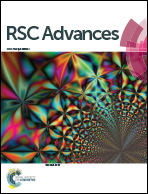Emulsion fabrication of magnetic mesoporous carbonated hydroxyapatite microspheres for treatment of bone infection†
Abstract
Hydroxyapatite is widely used for bone filling materials because of its compositional similarities to bone mineral and excellent biocompatibility, but it does not possess good osteoinductivity and bactericidal properties. Herein, magnetic mesoporous carbonated hydroxyapatite microspheres (MEHMs) have been fabricated using CaCO3/Fe3O4 microspheres as sacrificial templates. The cetyltrimethylammonium bromide/Na2HPO4 solution/cyclohexane/n-butanol emulsion system serves as a microreactor, in which the CaCO3/Fe3O4 microspheres are converted to MEHMs via a dissolution–precipitation reaction. MEHMs with low crystallinity exhibit the hierarchical nanostructures constructed by nanoplates as building blocks with mesopores and macropores, which give them high drug loading–release properties. The controlled release of gentamicin significantly minimizes bacterial adhesion and prevents biofilm formation against S. epidermidis. The Fe3O4 nanoparticles are dispersed within the microspheres, which makes the MEHMs magnetic. The biocompatibility and osteoinductivity of the MEHMs have been investigated using human bone marrow stromal cells (hBMSCs) as cell models. The Fe3O4 nanoparticles in the MEHMs not only stimulate cell adhesion and proliferation, but also promote the osteogenic differentiation of hBMSCs. The excellent biocompatibility, osteoinductivity, drug loading–release properties and bactericidal properties give the MEHMs great potential as bone filling materials to treat bone infection.


 Please wait while we load your content...
Please wait while we load your content...